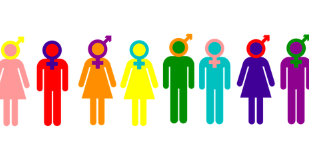A Journey Through Gender

Many children start to become conscious of their gender by the time they are two years old. They notice the differences between themselves and their classmates of a different gender, the way they are dressed, what toys they play with, how they act to fill gender roles. This awareness of gender can be the start of a journey that may last a lifetime. A lifetime of questions, stares, confusion, and doubt.
The first people I came out to as non-binary were my best friends. I started by requesting the use of “they/them” pronouns. They immediately made the switch—with a few bumps in the road. With that, I had started my journey through my gender and what it meant for me. Later, I would start to feel comfortable identifying as non-binary and choosing a new name.
The questions and confusion start when you meet me; I do not always express myself in androgyny. I wear dresses, heels, makeup, and love decorating with “girly” things in my cubicle at the Consortium. These choices do not make me any less non-binary. But with my female-presenting gender expression comes slip ups, and even my pronouns being completely ignored. Making the switch to the pronouns I use rather than the pronouns people assume for me can be difficult, but it is not less important just because it is hard.
My experience is not a unique one in the transgender and gender non-conforming community. By not asking a person's name and pronouns when you first meet them, doubt starts to fester. Is this a safe environment to come out in? Will people misgender me or assume my pronouns? Will I leave feeling defeated and mistreated?
As soon as an LGBTQ person walks through the door, the assessment begins. It's up to you to determine the outcome.
With an estimated 5.6% of the US population identifying as LGBTQ, it is more important than ever to normalize asking a person's name and pronouns upon meeting them. Too often pronouns are left out of introductions in group settings and in one-on-one conversations. It’s left to the person who uses pronouns that may not fit their gender expression to start the trend of sharing their pronouns and chosen name. This puts them in the tough position of immediately needing to out themselves to the group, especially if they are gender non-conforming or pre-transition.
Having every person in a group provide their name and pronouns takes enormous pressure off trans and nonbinary people, who otherwise have to share their pronouns or resign themselves to being misgendered.
This practice can also lead to open discussions about gendered language and how people are comfortable being addressed. Gendered generalizations such as “ladies” and “gentleman” can cause a sense of discomfort for many transgender people. Most people also assign pronouns without realizing it, using “she” and “her” for someone they assume is female, before asking the person what pronouns they actually use.
Understanding the unintentional gendered language and assumptions we make about people when we first meet them is an important first step in the creation of safe spaces for LGBTQ people.
Other tips for creating a safe and welcoming environment include:
- Having all staff include their pronouns in email signatures
- Including pronouns on business cards
- When applicable, putting pronouns on name badges
Subscribe for updates
_.webp)



